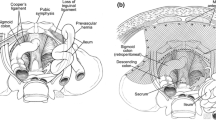Summary
The aim of this study was to assess the infective risks involved in the placement of a non-absorbable prosthesis in the abdominal wall, in the treatment of abdominal hernias. Two groups of patients were compared over the period 1985 to 1995. Group A (N=47) received non-absorbable (Mersilene) prostheses, placed in a potentially infected area (Altemeier class 2, 3 and 4). Group B (N=47, Altemeier class 1) comprised a similar group of patients to those in group A. The prostheses were usually placed in the retro-muscular prefascial plane. Antibiotics were given either prophylactically or therapeutically, according to the degree of sepsis surrounding the operation. The length of hospital stay was longer in group A (15.6 ± 9 as against 10 ± 6 days. p=0,0006). There were two deaths in group A and none in group B (not significant). The general complication rate was 23.7% in group A as against 8.5% in group B (p=0.016). There was no significant difference between the two groups in regard to surgical complications (group A 23.7%, group B 21.3%). The infection rate in the abdominal wall was 10.6% and 6.4% in groups A and B respectively (not significant). There was only one patient with a prosthetic infection (in group A) requiring revision. We conclude that the use of non-absorbable prostheses placed in the retromuscular prefascial space may be more widely employed, in the course of potentially contaminated intra-abdominal surgery of Altemeier class 2.
Similar content being viewed by others
References
Adloff M, Arnaud JP (1976) Étude expérimentale de la résistance et de la tolérance biologique des matériaux prothétiques utilisés dans la réparation des pertes de substance de la paroi abdominale. Chirurgie 102: 390–396
Champault G (1988) Place des treillis résorbables dans le traitement des éventrations post-opératoires. J Chir 125: 27–29
Chevrel JP, Flament JB (1990) Rapport au Congrès de l'Association Française de Chirurgie: Les éventrations de la paroi abdominale. Actualités Digestives Médico-Chirurgicales. Masson, Paris
Cubertafond P, Sava P, Gainant A, Ugazzi M (1989) Cure chirurgicale des éventrations post-opératoires par plaque prothétique. Chirurgie 115: 66–71
De Manzini N, Rohr S, Thiry LC, Meyer CH (1993) Traitement des éventrations péristomiales par abord direct et prothèse rétro-musculaire. Lyon Chir 89: 287–289
Louis D, Stoppa R, Henry X, Verhaeghe P (1985) Les éventrations post-opératoires. J Chir 122: 523–527
MacLanahan D, King LT, Weems C, Novotney M, Gibson K (1997) Retrorectus prosthetic mesh repair of midline abdominal hernia. Am J Surg 173: 445–449
Rath AM, Zhang J, Amouroux J, Chevrel JP (1996) Les prothèses pariétales abdominales. Étude biomécanique et histologique. Chirurgie 121: 253–265
Rives J, Pire JC, Flament JB, Palot JP, Body C (1985) Le traitement des grandes éventrations. Chirurgie 111: 215–225
Société Française d'Anesthésie et de Réanimation (1992) Conférence de consensus: Antibioprophylaxie en milieu chirurgical chez l'adulte. Paris
Stoppa R, Henry X, Verhaegue P, Odimba BFK (1981) Tendances actuelles du traitement chirurgical des déhiscences chroniques de la paroi abdominale. Bull Acad Nat Med 165: 493–501
Stoppa R, Warlaumont C, Verhaeghe P, Odimba BFK, Henry X (1982) Comment, pourquoi, quand utiliser les prothèses de tulle de Dacron pour traiter les hernies et les éventrations? Chirurgie 108: 570–575
Sugarbaker PH (1980) Technique of repair of herniations associated with colonie stomas. Surg Gynecol Obstet 120: 347–349
Sugarman HJ, Kellum JM, Reines HD (1996) Greater risk of incisional hernia with morbidly obese than steroid-dependent patients and low recurrence with prefascial polypropylene mesh. Am J Surg 171: 80–84
Temudom T, Siadati M, Sarr MG (1996) Repair of complex giant or recurrent ventral hernias by using tension-free intraparietal prosthetic mesh (Stoppa technique): Lessons learned from our initial experience (fifty patients). Surgery 120: 738–743
Vayre P, Majeski M, Duron JJ (1996) Le matériel prothétique a-t-il une place raisonnable dans le traitement des urgences herniaires? Chirurgie 121: 161–162
Wantz GE (1991) Incisional hernioplasty with mersilene. Surg Gynecol Obstet 172: 129–137
Wittman DH, Schein M, Condon RE (1995) Antibiotic prophylaxis in abdominal wall hernia surgery: Never, always, or selectively? Problems in General Surgery 12: 47–55
Author information
Authors and Affiliations
Rights and permissions
About this article
Cite this article
Vix, J., Meyer, C., Rohr, S. et al. The treatment of incisional and abdominal hernia with a prosthesis in potentially infected tissues — A series of 47 cases. Hernia 1, 157–161 (1997). https://doi.org/10.1007/BF01234750
Received:
Accepted:
Issue Date:
DOI: https://doi.org/10.1007/BF01234750



